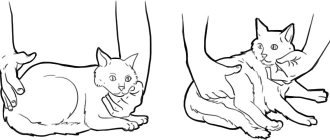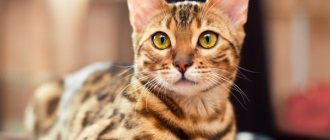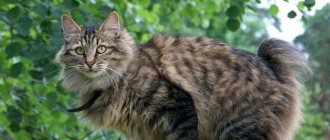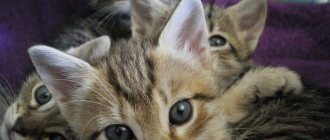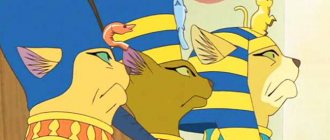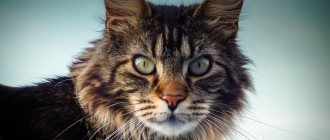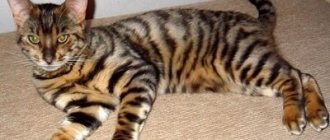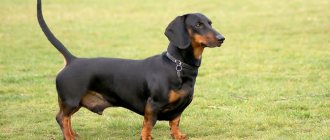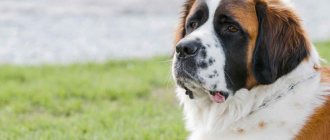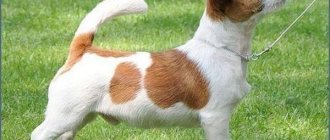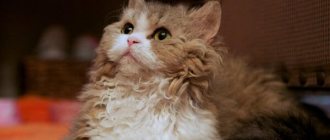History of the origin of Abyssinian cats
The Abyssinian cat has as many as 5 theories of origin. They are all connected by a similar appearance, but differ in geography:
- Abyssinian (Ethiopian) says that the Zula cat was brought to England from these places. According to history, in 1868 her offspring gave rise to the breeding of the Abyssinian breed, but there are no reliable sources to support the theory.
- The Egyptian version is confirmed by numerous images of cats on the frescoes of houses, which are very similar in appearance to the modern Abyssinian breed. From these pictures we can say that such specimens were considered sacred, messengers of the goddess of fun Bast. “Cats of the sun” were kept both in simple houses and in temples.
- The wild African theory exists because of the prairie cats that live there to this day. They also have the characteristic features of the breed.
- The East Asian hypothesis relates to the standard tabby color, which was not found in African breeds. The veracity of the version is supported by one exhibit of the Leiden Zoological Museum, on which hangs a sign: “Patri, a domestic cat from India.”
- The English version talks about persistent breeding work with aboriginal cats. In 1871, a similar cat with tufted ears, stripes all over the body and anatomical features was exhibited at the Crystal Palace Exhibition in London.
In any case, the breed began to actively develop in Great Britain, where prominent representatives of the species were crossed with other breeds to obtain the ideal combination. The species was officially registered at the end of the 19th century and then began to spread throughout the world. Today, many breeders are working to preserve the breed in its original form without impurities.
Character
Although the beauty of this breed wins the heart of a person, its character turns him into a fanatic. Lovers of Somali cats say that they are the best domestic creature you can buy, and claim that they are more people than cats.
Small, fluffy, hyperactive people. They are not for those who like passive, couch cats.
They are similar to foxes not only in color and bushy tail, they seem to know more ways to create a mess than a dozen foxes. But whether you find such a mess charming depends on you and the time of day.
It's much less charming if you hear the deafening crash of dishes hitting the floor at 4am.
They are very smart, which is reflected in their ability to play mischief. One amateur complained that his Somali stole his wig and appeared with it in her mouth in front of guests. If you decide to get this cat, you will need patience and a sense of humor.
Fortunately, Somali cats do not scream except in extreme cases, such as when they need a snack. Given their activity, they need frequent snacks. However, when they need to communicate, they do this by meowing or purring.
Somalis are also known for their courage and tenacity. If something comes to their mind, then you better give up and concede or prepare for an eternal battle. But it's hard to be angry with them when they purr and cuddle up to you. Somalis are very people-oriented, and become depressed if they are not given attention. If you are away from home most of the day, then you should buy her a companion. However, remember that two Somali cats in the house equals many times more chaos.
By the way, as lovers say, these cats are not meant to be kept outdoors, they are completely indoor cats. They live quite happily in an apartment, provided they can run everywhere and have enough toys and attention.
Appearance
Abyssinian cat and kitten
The Abyssinian cat breed has a bright, exotic appearance: a sinewy body, original colors, expressive eyes. In many ways they resemble the Bengal breed, however they have their own individual characteristics.
Abyssinian color
The cat's entire body is covered with silky, short guard hairs, under which a tight-fitting down grows. At the same time, the hair on the back of this breed is slightly longer.
The breed standard contains a description of 4 colors:
- Wild (ruddy). The most common due to its initial recognition as a standard for the breed and the dominant gene that has formed (if at least one parent has a wild color, then absolutely all kittens in the litter will be of this shade). The coat is orange-brown in color, shimmers in the sun, and a dark (black, dark brown) line stretches along the ridge (see photo).
Abyssinian ruby cat
- Sorrel, red. Bright apricot color, which in some places turns into chocolate areas. In this case, the presence of black hairs is unacceptable.
- Beige (fawn). Caused by a combination of two recessive genes, it is therefore rare in the breed. The beige pink color looks beautiful, like a very lightened version of sorrel.
Abyssinian breed red and beige
- Blue The gray-blue color of the coat is combined with pink-beige undercoat on the belly and the inner surface of the limbs.
Abyssinian blue kittens
A special feature of the breed is that each hair has from 2 to 5 different pigments. On the belly, chest and inner surface of the limbs the spine is lighter than on the tip of the tail, back and soles of the hind legs. However, this is visible only when the kitten is about six months old, when the color becomes more expressive.
Anatomical characteristics
- Head. Wedge-shaped with rounded, smooth lines. The ears are large, set wide, slightly tilted forward. Their base is wide and their tips are rounded. The head is supported on a graceful, elongated neck.
- Muzzle. The nose is of medium length, straight. The chin is rounded, well developed, and in males it can merge into noticeable cheeks. The eyes are almond-shaped, slightly slanted, colored amber or green and have a black rim that visually continues the eyelids.
- Body. The body is proportional, moderately stretched. The chest is rounded, causing the back to be slightly arched. The limbs are long, thin, with neat oval paws and tightly pressed toes.
- Tail. Long, thin, tapering strongly towards the end.
Due to the long-standing division between the American and European breeds based on the appearance of the former, you can notice the emphasis of breeders on a more graceful physique (see the photo!).
Graceful Abyssinian cat on a tree
Dimensions and weight
The average body weight of an adult is 3-4.5 kg, while the breed does not have very developed sexual dimorphism (the cat weighs slightly less than the male). The body is graceful, lightly built, height at the withers is up to 35 cm in males and up to 28 cm in females.
Possible breed defects
Variants of the non-pedigreed appearance of Abyssinian cats include the following characteristics:
- short limbs;
- round or elongated head;
- Round eyes;
- absence of a black rim around the eyes;
- short tail;
- small ears;
- crease of the tail;
- color not meeting the standard;
- Siamese type body type.
Abyssinians who have at least one of these breed defects (as in the picture) will not receive high marks from experts, and therefore will not be able to participate in targeted breeding.
Spotted Abyssinian cat
How to tell if your pet is overweight
How can you tell when it’s time for your Abyssinian pet to go on a diet? Firstly, you will notice how quickly your pet gets tired after active games. Just a few minutes after the start of the game you will notice heavy, “dog” breathing. Second, look down at your pet while the animal is standing on all fours, or take a photo of it.
In an overweight Abyssinian, you will immediately notice prominent sides on both sides of the body. If you feel your pet, you will find a significant layer of fat on the chest, abdomen, back, but the ribs and spine will be almost invisible. If obesity has gone too far, it is better to consult a veterinarian, who will select a special diet for the animal and calculate the daily food intake.
Character and habits of Abyssinian cats
Character of the Abyssinians
Before purchasing a cat for a home, future owners should study the habits of the Abyssinian cat breed. The character of these animals combines the behavior of a wild animal, the affection of a domestic pet and the devotion of a dog. So, in addition to individual character traits, cats of this species have 7 common traits:
- Curiosity. Even if the apartment is completely examined, the cat will find a new place to sleep. He will try to catch a stream of water with his paw, watch the laundry in the washing machine, and try out new toys. You also need to prepare for the fact that your pet will climb tables, cabinets and generally all high surfaces. The tendency to explore everything pushes the Abyssinian to such an unpleasant action as theft. Therefore, it is important to ensure maximum safety for this overly inquisitive cat: there should be protective bars on the windows, the entrance doors should always be closed, and dangerous objects and wires should be securely hidden (and put away in an inaccessible place, and not somewhere higher).
Abyssinians definitely need a house with high platforms
- Playfulness. They have a perpetual motion machine hidden under their tail, so the cat is always on the move when he is not sleeping. And these cats are natural acrobats. They jump high and can do somersaults or run along walls.
The Abyssinian breed is very playful
- Sociability. When the owner is at home, they will always be nearby, and when greeted from the street, they will raise their tail with a pipe and begin to meow joyfully. Experienced owners say that cats love to sleep with them in an embrace, climbing right under the blanket.
- Talkativeness. They make an incredible amount of sounds: they sing when begging for food, out of boredom, or during estrus. The voice turns on if you don’t like something – for example, if you put it in a carrier.
- Affectionateness. These cats purr loudly, while looking for affection themselves, bumping their heads against a person, licking hands, kneading their knees with their paws, and willingly allow themselves to be stroked.
- Trainable. Both adults and children love to play. Therefore, together with the intelligence of the animal and the imagination of the owner, games can move to a new level: run after a toy, give a paw, perform various commands, tricks.
Abyssinians are easy to train
- Deeply attached to a person. Abyssinians feel sincere affection for their owner, but only for one “favorite” person from the family. They do not tolerate separation well, they are very bored while the owner is away, even to the point of health problems.
Representatives of this breed get along well with children of all ages. For very little ones they become nannies, guarding their sleep for hours, calling
adults when the baby wakes up. With the elders they actively play catch, ball, and hide and seek.
Because of their curiosity, the animal treats guests well; they perceive them not as a threat, but as an object for study. They will be happy to greet guests from the doorstep and will respond with gratitude to the attention to their person.
Abyssinians are also good with pets in the neighborhood. They know how to build friendly relationships and take on the role of ringleader in an animal gang. Busy people are even recommended to get a second pet for their Abyssinian so that they don’t get bored in the owner’s absence. However, birds and rodents cannot act as a neighbor; the cat perceives them as prey.
The Abyssinian breed is friendly with children of all ages, other pets and guests.
Partner selection
Selecting a partner is an important point in breeding cats.
You can intuitively choose a suitable partner for mating if you select a pair based on external signs: tail length, ear position and head shape. But it’s unlikely to be possible to predict the color of future kittens. To be able to determine it, you need to use a special technique. Fortunately, the color genetics of representatives of this breed are quite accessible and simple.
It is very difficult to plan the color of future Abyssinians
It should be noted that a mixture of colors provided for by the standard can lead to the most unexpected results. The best option is to calculate the color using specific genetic formulas, in order to avoid colors that are unacceptable for this breed. Before this, you should carefully study the pedigrees of the parents of future kittens and then keep careful records of the offspring. This will allow you to have the maximum possible information about the producers in the future, which will make it possible to plan future matings more intelligently and carefully.
Caring for an Abyssinian cat
Due to their short, smooth coat and generally good health, caring for them does not require any special skills. However, basic actions are still needed to maintain cleanliness:
- Wool. Once every 2 weeks you need to comb with a metal brush with frequent teeth. For show cats, a grooming procedure is carried out using suede; it smoothes the fur and enhances the natural shine. The animal is washed with a special shampoo for short-haired breeds, but the procedure is carried out as necessary.
- Ears and eyes. Clean with the same frequency using a cotton pad soaked in water. This is necessary to prevent infection, which the animal's large ears and eyes are so prone to.
- Teeth. Brush with cat paste once a week, as the breed is prone to periodontal disease. For the same purpose, the pet is offered special treats that can be chewed and at the same time clean the teeth of soft deposits. Regular visits to the veterinarian for an oral examination and tartar removal are also required.
- Claws. Overgrown claws are trimmed with a nail clipper once every 2 weeks, to the level of a curved transparent tip, so as not to damage the blood vessels. It is also recommended to equip a scratching post; they quickly learn to sharpen their claws where they should be.
- Walking. You can keep your pet active with walks in the fresh air. This way he won't get bored because of the small space in his apartment to play. However, it is not recommended to let the animal off the leash; the curiosity inherent in the breed can lead to loss.
Abyssinian cat on a walk
In addition to body care, the owner needs to monitor the cleanliness of the cat's litter box. They are big clean people, so they won’t go to an uncleaned toilet.
Care and maintenance
Abyssinians are unpretentious, but their health requires attention so that the pet gets sick less often and lives a long time.
Getting to know your new home
Abyssinian
When bringing a kitten into your home, remember that he is very shy, so you should introduce him to the outside world, family members, and pets slowly. Pay attention to him, but do not overload him with games, so that the baby has time to get stronger and get used to the new environment. The animal explores the house on its own; it is worth providing it with a separate comfortable bed and scratching post.
Hygiene
Abyssinian cats are easily accustomed to a tray with natural filler or to the toilet. If you accustom your pet to water procedures from a tender age, in the future there will be no problems with bathing at all - most of the representatives of the breed love to swim. It is advisable not to wash the animal too often; once during the molting period is enough. In this case, use a special shampoo for short-haired cats (without conditioner). After bathing, dry your pet thoroughly and let it dry.
It is worth brushing your Abyssinian cat's teeth periodically, as she is prone to plaque and tartar formation. Particular attention should be paid to keeping the ears clean.
Wool
The short, dense coat requires virtually no grooming. It is enough to go through the wool with a special brush once a week. Molting goes quickly and does not cause any particular inconvenience.
Nutrition
Abyssinians will willingly eat special food or food you prepare. In the latter case, you should consult a veterinarian who will prescribe additional vitamins and nutritional supplements. Pay a little attention to the diet so as not to overfeed the animal. Up to one year of age, kitten food should be provided three times a day. It is advisable to use the same brands that the breeder fed the babies. Upon reaching one year of age, you can switch to products for adult cats, giving a slightly larger portion twice a day.
It is advisable to cook meat and fish; give raw foods only when you are sure of their quality and after cutting them into small pieces. Many Abyssinian cats enjoy eating fruits and vegetables - over time, you yourself will understand which ones your pet prefers.
Kus
My man loves me
Diet
You can feed with natural products or ready-made food, but it is recommended to decide on the type of food right away so as not to subject the animal’s gastrointestinal tract to experiments. The average formula for calculating the daily portion is 7-7.5% of the animal’s weight.
The basis of natural nutrition should be animal proteins:
- Raw meat (chicken, turkey, lean beef, rabbit);
- Sea fish (1-2 times a week, boiled and without bones);
- Raw quail eggs;
- Boiled and raw vegetables, fresh greens (carrots, beets, zucchini, pumpkin, broccoli, spinach, cauliflower, bell peppers, green peas, lettuce, beet and turnip tops);
- Fermented milk products without additives, 0-1% fat (cottage cheese, yogurt, fermented baked milk, kefir);
- Fruits (apple, pear);
- Brewer's yeast;
- Dried kelp.
It is recommended to select a vitamin and mineral complex for this diet, taking into account the age and physiological state of the cat.
Good nutrition is the key to healthy coat of the Abyssinian breed
When choosing industrial food, focus on super premium and holistic food classes. They have an optimal composition: a balance of proteins and fats, essential minerals, vitamins and amino acids.
Characteristics of Abyssinians
Despite their similarity to their wild counterparts, Abyssinian cats have a fairly balanced character. As a rule, they do not misbehave and do not use their teeth and claws without good reason. With proper training, they will not damage furniture, sharpen their claws on it and jump on curtains and carpets. Moreover, as a rule, they understand the ban the first time.
Abyssinians are very intelligent, easy to train and have a lively temperament. Both kittens and adults play with pleasure and for a long time. Another distinctive feature is their insatiable curiosity.
They stick their nose wherever possible, “help” their owner in all household chores, following him everywhere.
Abyssinian cats are highly resistant to stress and socialized, so they get along well with both other felines and dogs.
Despite their clearly expressed focus on people and devotion to him, Abyssinians are quite independent and require respectful treatment.
Education and training
Abyssinians are able to remember a large number of commands, in this they are very similar to monkeys or dogs. Education begins at the age of 2-7 months. By following a number of rules, the results of your training can be seen almost immediately:
- training is not mandatory and is perceived by the pet as a game;
- during classes do not use a strict tone or physical punishment - such actions will provoke retaliatory aggression;
- patient conversations are a technique that works flawlessly on Abyssinians, especially when rewarded with a favorite treat.
These tips are the basis for a trusting relationship between owner and animal. Using them, it is quite easy to train a cat to give a paw, bring a small object, or use the toilet.
How to train Abyssinian cats?
Active manifestations of the Abyssinian character
People love feline pets for their affection and cozy purring. Representatives of the Abyssinian breed, having a naturally quiet, gentle voice, do not meow demandingly often, and scream or hiss even less often. But to show a friendly attitude by purring pleasantly in regular intervals is in the character of both male and female cats. They do this both as a greeting to the returning owner, and in moments of peace, half asleep next to or on the owner’s lap.
The Abyssinian, who loves to be aware of what is happening, is looking for a higher place for an observation post. Can choose a closet, the back of a sofa, a refrigerator. Therefore, the ideal solution to satisfy natural needs is to place a ladder with an attached stable viewing platform. A house for privacy would also be useful.
A person must take into account that the Abyssinian cat, which has an active lifestyle, needs physical activity. When an animal has the opportunity to move a lot, it looks magnificent, admiring its grace and dexterity.
Breeding Abyssinians
Puberty in females occurs early, with the first estrus beginning at the age of 4 months. However, according to international recommendations, the first mating should take place only after 3 cycles (when the cat has matured to 8-9 months).
The mating process itself takes place on the territory of the “suitor”. Cats show much more interest in the process than cats, who may hide at first. Therefore, for a successful result, it is recommended to leave them in solitude for 2-3 days.
Pregnancy lasts about 65 days, during which the expectant mother needs special care from the owner to avoid unnecessary stress. But the Abyssinian cat has a highly developed maternal instinct, so the owner can count on a successful litter of 5-6 kittens.
Abyssinian color
According to international standards, the Abyssinian cat is divided into four types:
- Blue Has bluish hair ticking. The wool has a beige, bed color.
- Wild color (ruddy). Black hair ticking. The fur itself is dark brown.
- Red, sorrel (red). Chocolate brown hair ticking. The fur color is red.
- Beige (fawn). Light brown hair ticking. The wool has pink-beige shades.
Diseases of Abyssinian cats
Like all animals, the Abyssinian species is susceptible to some diseases. Predisposition to the following diseases is due to genetics:
- problems with the gastrointestinal tract;
- periodontal disease;
- allergy;
- polycystic kidney disease;
- gingivitis;
- progressive retinal atrophy;
- spontaneous hyperesthesia syndrome, psychogenic alopecia;
- blood diseases (pyruvate kinase deficiency);
- leukemia.
What diseases are Abyssinians susceptible to?
These diseases are easily diagnosed using a genetic test, always before the birth of offspring, in order to avoid health problems. Many of the diseases, such as gastrointestinal and oral disease, can be resolved with careful care and regular visits to the veterinarian.
Buying an Abyssinian kitten
Abyssinian kittens
The best age to buy a kitten is 12 weeks and older. By this age, he has had his vaccinations, he can do without his mother’s support, and he is litter box trained.
Abyssinian kittens, depending on pedigree, color and gender, cost from 10,000 to 50,000 rubles. In this case, the following classes of kittens are distinguished:
- The Pet class has external flaws and is therefore prohibited for breeding;
- Breed class is allowed for mating, but not for exhibitions;
- Show class kittens have an excellent exterior and are allowed for mating and exhibitions.
Depending on the goals, the future owner chooses a kitten in the appropriate class, and it is recommended to look for a purebred kitten from well-known breeders and nurseries.
WCF standard
The body
is muscular, of medium size, strong, flexible, dense, of medium length.
Tail
rather long, pointed, thick at the base.
Limbs
sinewy, long and slender. The paws are narrow and oval.
Head
wedge-shaped, medium proportions, soft contour, a slight notch at the transition to the muzzle is desirable. When viewed from the front, the muzzle is rounded and fits into a parabola, pointing downwards. Strong chin, medium length nose. The profile is without a stop, but not straight either, the forehead is slightly convex. Graceful neck.
Ears
large, widely and vertically set and wide at the base. The tips are rounded, with a “thumb print”, tassels on the ears are desirable.
Eyes
large, shiny, expressive, almond-shaped. Wide apart, slightly oblique (the outer corners of the eyes are higher than the inner ones). Color - pure, clear, juicy amber yellow or green, with eyelid rims.
Wool
short, thin and tight-fitting. Double or triple ticking. Dark ends of hair are preferred.
Flaws:
White spots, white medallion, too much white on the chest, closed necklaces, gray or too light undercoat, too little ticking, moire stripes. Pattern/stripes on the face or limbs. In dark colors there is no dark tip of the tail, dark “soles” on the hind legs, or dark rims on the eyelids.
Siamese type, round head, small or pointed ears, round eyes, mixed eye color, too noticeable feet.
| Body: 20 points Head, ears: 15 points Eyes: 10 points Color: 25 points Ticking: 15 points Texture: 10 points Condition: 5 points |
Colors:
Wild color, sorrel, blue, beige fawn, tortoiseshell, tortoiseshell sorrel, blue tortoiseshell, tortoiseshell fawn, black silver, sorrel silver, blue silver, fawn silver, blue tortoiseshell silver, tortoiseshell fawn silver
